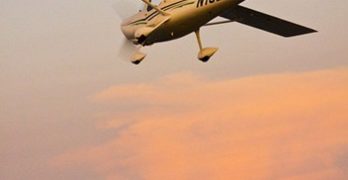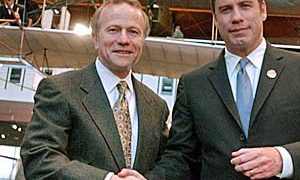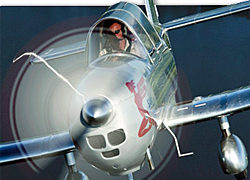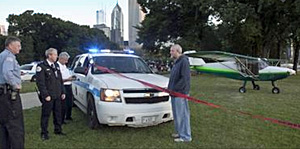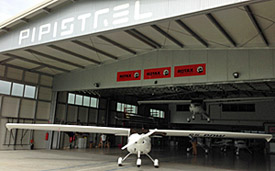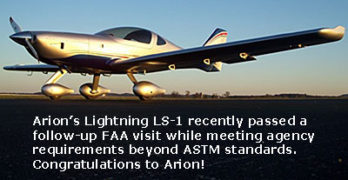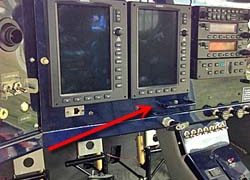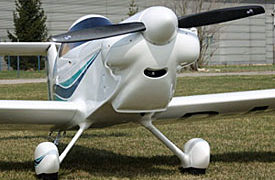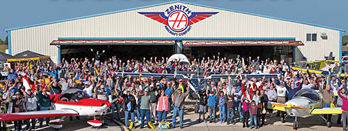A story posted by Daniel McCoy, a reporter for the Wichita Business Journal, claims the star-crossed Cessna 162 Skycatcher will likely not enjoy the longevity and success of other notable Cessna icons such as the C-172 and C-150/152. Skycatcher was one of the first SLSA out of the gate for the new category created by FAA in 2004. But troubles with manufacturing and two highly publicized airframe parachute deployments during flight testing, including an airframe redesign after the first one, contributed to the dark cloud that seemed to follow the once-bright promise of Cessna’s entry. The market-perceived lackluster specifications sheet and barebones/industrial interior finish relative to many other LSA entries also contributed to the steady attrition in the once-1000-plus order sheet for the Skycatcher.
The news came yesterday at the NBAA (National Business Aviation Association) confab in Las Vegas. Company CEO Scott Ernest made the remark that Skycatcher had difficulty attracting market share and had lost a sizable percentage of its multi-year back orders.
Tom Poberezny; AOPA Survey; Good Bye, Skycatcher!
Once upon a time, way back at the dawn of LSA — 10 years ago come next Oshkosh — I consulted to EAA about the then-new emergence of Sport Pilot / Light-Sport Aircraft. In those days, Tom Poberezny was running the show. In 1989 he took over from his dad, affectionately known to some as Pope Paul. By then, Tom had been a major figure in aviation for many years. When I worked inside EAA HQ during 2004 and 2005. I often had the pleasure of meeting with Tom and occasionally his wife Sharon. I can’t say we became good friends, but we got to know each other and we both wanted great things for aviation. Zap ahead to AirVenture 2011 when a troubling thing happened. As since-departed Rod Hightower took over as President of EAA, the organization appeared to abruptly shove Tom to the sidelines. About the same time, Phil Boyer left the top job at AOPA and the contrast could not be more sharp.
Flying Sam; “A Warbird for the LSA Market”
To some it’s a new entry in the LSA race (Sam LS is presently selling kits while pursuing SLSA acceptance). To others the Canadian LSA is a “mini T-6” or a “mini Yak 52.” Either characterization no doubt pleases designer Thierry Zibi. During development he did a thorough job of asking airshow visitors what appealed to them. Now that Sam is flying, it is fair to say that even with the availability of 132 other Light-Sport Aircraft models, Sam LS is unique. At AOPA’s last-ever Summit event in Fort Worth, Texas, I got a chance to take Sam aloft with Thierry overseeing from the aft seat. Short tell: it may look like a miniature warbird, but flies with very solid and pleasant qualities.
As the sun-drenched photos reveal, Thierry’s airplane glistens with polished aluminum, an uncommon appearance on airport ramps loaded with brightly painted aircraft accented with jaunty striping.
Flight Report: UL Power 350 in the S-7S
Rans designer Randy Schlitter is one of those restlessly creative types. Many aviators are aware he’s created twenty airplane designs and these are not all variations on a theme. While a few are based on another, several are completely fresh approaches. Way back when, we used to joke about the Rans design-of-the-month club, so often did he emerge at an airshow with somethings we’d never seen. If that’s not enough he’s also been making bicycles for a few decades. (My wife and I each ride one and love them.) He runs Rans Aircraft and Rans Bicycles as side-by-side enterprises. Still not content, Randy does a bit of writing and has produced some artwork. My advice for most folks: don’t try to keep up. Randy is likely to leave you far behind. So, when I saw an installment of his “Into the Flight” series — this one after flying one of his S-7 Couriers with a UL Power 350 engine installed — I asked if I could reprint it here.
Rans Aircraft in the News … Twice!
After losing the trim tab on the elevator of his Rans S-6, John Pederson of Lombard, Illinois grappled with a violent shaking and executed an emergency landing on Chicago’s Lake Shore Drive. He was flying very early so traffic on the multi-lane route was light. Pederson reported timing his landing to avoid any traffic, though local sources reported the airplane was struck by two autos both of which sped away afterward. Unable to regain stability, the 51-year-old electrician radioed a mayday to O’Hare International Airport and then set up for landing. A recording of the radio call revealed John behaving calmly and, indeed, no one was injured in the highly-publicized incident. “At the time of the mayday call, about 6 a.m., he was flying about 1,900 feet above [Chicago’s downtown] Millennium Park, he said,” according to a report on the Chicago Tribune‘s online website.
The good news is no one was injured and while media reports poked fun at Pederson’s very visible downtown Chicago landing, the report can nonetheless be viewed more or less positively.
After Aero — Visiting Rotax and Pipistrel
We paid two memorable visits after Aero ended and I’ll tell you a little about each one … but first … While I was at Pipistrel in the office of boss Ivo Boscarol, he received word that Matevz Lenarcic had reached the North Pole on his flight reported earlier. Congratulations on this achievement; a long flight across the North Atlantic remains. Godspeed! ••• The two visits were to Rotax Aircraft Engines and to Pipistrel. These two are not geographically far apart and work closely. Each spoke highly of the other and both companies are highly impressive places to visit.
BRP-Powertrain is the parent behind Rotax Aircraft Engines. Though occupying a sizeable amount of real estate in the immense BRP-Powertrain factory, the aircraft engines are the “hand built” portion of the production. Fast-paced, largely-automated, robot-assisted assembly lines manufacture many thousands of engines each year for such products as SeaDoo, BMW motorcycles, and other well-known brands.
Simple Aircraft (Like LSA) Need Simple Rules
In this post I’m going to do something potentially risky. I am going to make some statements about the politics of aircraft certification. While rather dull, this subject is nonetheless something pilots and others feel rather strongly about as the safety of aircraft — for persons in or under aircraft — is involved. Doesn’t everyone except a handful of thrill seekers care deeply about safety? I certainly do yet I feel it’s time for some new directions. I fully expect not everyone will agree, but I feel strongly that these statements need to be made. So, here goes …
My term as Membership Secretary of ASTM’s F37 LSA committee will complete later this year; I will be term limited out. That’s perfectly fine … I’ve done my duty for several years. ASTM’s F37 committee is the group that wrote and updates the standards used to gain acceptance for Light-Sport Aircraft. F37 is populated by some exceptional people that are largely unsung heroes for all the hard work they’ve done with little recognition.
Oshkosh 2013 Elements, Part 3: Slide-Out Panel
Elements are basic components of nature. As in our first two parts, I see Oshkosh Elements as worthy ideas other than airframes or engines. One such is World Aircraft Company‘s roller-bearing pull-out drawer instrument panel. Now, if you are like me and don’t spend a lot of time around your airplane with a wrench or soldering iron in your hands, you might not see why this is important. For panels with a collection of round instruments, maybe it isn’t as fetching an idea. Yet I’m willing to guess that nearly every mechanic who reads this or hears of World’s innovation is going to say, “Yes! Why hasn’t this been done before and why aren’t all instrument panels done this way?”
Early this year, I watched while two avionics mechanics maneuvered around the instrument panel in a Flight Design CTLSi. Their task was to install ADS-B hardware to coordinate with the dual-screen Dynon SkyView that fills left and right bays of the instrument panel.
SD-1 Minisport: the First SLSA Single Seater?
We looked at this airplane at AirVenture Oshkosh 2012 (video). At that time the Orem, Utah team presented their wood and composite airplane as a kit. In a year a lot changed and now SkyCraft is pushing ahead with plans for a Special LSA that will be delivered fully built for the modest price of $54,850. CEO Tyler Ives says the company is ready to declare compliance to ASTM standards and after they get a chance to prove that to FAA, the SD-1 Minisport might become the very first single seat Special Light-Sport Aircraft, a distinction that once earned will last forever. The only other candidate presently known is the Tecnam Snap aerobatic LSA. Given that Tecnam has achieved more LSA models than any other company, you should never count them out so the race is on to be the first-ever single seat SLSA.
Zenith Opens Its Hangar to Big Crowds
We interrupt our series on Oshkosh Elements to highlight the upcoming Zenith Open Hangar Day. The event taking place on Saturday, September 21, 2013 is the company’s 22nd annual such event and it draws a large crowd as you can see in last year’s photo. Normally, one company opening its doors to customers and visitors is not big news but Zenith has done particularly well with their open house. For many recent years, Zenith has steadily been delivering kits at the rate of about 200 units per year, a volume most airframe makers would love to match and one that puts Zenith near the top of the list (if not the alphabet). It means the company has developed a large following and, when invited, they turn out. Given the focus on the Midwest LSA Expo at the beginning of September, one could say the Midwest will be active region for LSA and light kit enthusiasts.
- « Previous Page
- 1
- …
- 13
- 14
- 15
- 16
- 17
- …
- 52
- Next Page »


